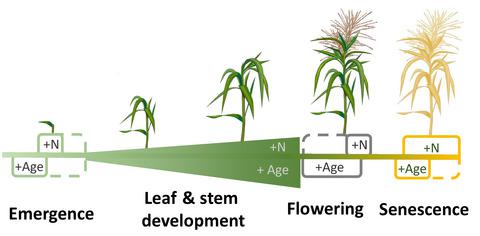当前位置:
X-MOL 学术
›
GCB Bioenergy
›
论文详情
Our official English website, www.x-mol.net, welcomes your
feedback! (Note: you will need to create a separate account there.)
The older plant gets the sun: Age‐related changes in Miscanthus × giganteus phenology
Global Change Biology Bioenergy ( IF 5.9 ) Pub Date : 2020-08-31 , DOI: 10.1111/gcbb.12745 Mauricio D. Tejera 1 , Fernando E. Miguez 1 , Emily A. Heaton 1
Global Change Biology Bioenergy ( IF 5.9 ) Pub Date : 2020-08-31 , DOI: 10.1111/gcbb.12745 Mauricio D. Tejera 1 , Fernando E. Miguez 1 , Emily A. Heaton 1
Affiliation

|
Age‐related changes are usually overlooked in perennial grass research; when they are considered it is usually as a change in plant size (e.g., biomass). Whether other physiological or developmental aspects change as stands age, and how those aspects may impact long‐term stand dynamics, remains unclear. Conventional experimental designs study a single stand over multiple growing seasons and thereby confound age‐related changes with growing season conditions. Here we used a staggered‐start experimental design with three repeated planting years over two growing seasons to isolate growing season effects. We studied changes in Miscanthus × giganteus phenology during its yield‐building stage (first 3 years) and estimated age, growing season and nitrogen (N) effects on development using nonlinear regression parameters. Stand age clearly changed plant growth; faster developmental rates were usually seen in 1‐year‐old stands (young), but because 2‐ and 3‐year‐old stands (mature) emerged 3 months earlier than newly planted stands they produced  30% more stems with 30%–60% more leaves. Nitrogen fertilization modulated some age‐related phenological changes. Fertilized 2‐year‐old stands reached similar stem densities as unfertilized 3‐year‐old stands and had fewer number of senesced leaves like 1‐year‐old stands. In addition, N fertilization had no effect on young M. × giganteus, but extended mature stands’ growing season more than 2 weeks by hastening emergence and delaying senescence. It also delayed flowering regardless of stand age. Our results suggest that, along with changes in size, M. × giganteus stands showed shifts in developmental strategies: young stands emerged later and developed faster, while mature stands grew for longer but more slowly. In temperate regions, where hard frost events are likely to interrupt development in late autumn, rapid early development is critical to plant survival. Nonlinear regression parameter differences proved effective in identifying phenological shifts.
30% more stems with 30%–60% more leaves. Nitrogen fertilization modulated some age‐related phenological changes. Fertilized 2‐year‐old stands reached similar stem densities as unfertilized 3‐year‐old stands and had fewer number of senesced leaves like 1‐year‐old stands. In addition, N fertilization had no effect on young M. × giganteus, but extended mature stands’ growing season more than 2 weeks by hastening emergence and delaying senescence. It also delayed flowering regardless of stand age. Our results suggest that, along with changes in size, M. × giganteus stands showed shifts in developmental strategies: young stands emerged later and developed faster, while mature stands grew for longer but more slowly. In temperate regions, where hard frost events are likely to interrupt development in late autumn, rapid early development is critical to plant survival. Nonlinear regression parameter differences proved effective in identifying phenological shifts.
中文翻译:

较老的植物获得阳光:芒草×巨嘴鸟物候的年龄相关变化
与年龄相关的变化通常在多年生禾草研究中被忽略;当考虑它们时,通常是植物大小(例如生物量)的变化。尚不知道其他生理或发育方面会随着林分年龄的变化而改变,以及这些方面如何影响林分的长期动态。传统的实验设计研究多个生长季节中的单个林分,从而将与年龄相关的变化与生长季节条件相混淆。在这里,我们采用了交错启动的实验设计,在两个生长季节中重复种植了三年,以隔离生长季节的影响。我们研究了Miscanthus×giganteus的变化物产建立阶段(前3年)的物候学,并使用非线性回归参数估算年龄,生长季节和氮(N)对发育的影响。林分年龄明显改变了植物的生长;通常在1岁的幼林(年轻)中观察到较快的生长速度,但是由于2和3岁的幼林(成熟)比新栽种的林早3个月出现,所以它们的 茎增加了30%,即30%–60叶子多%。氮肥调节了一些与年龄有关的物候变化。受精的2年生林分的茎密度与未受精的3年生林分相似,并且感性叶片的数量少于1年生林分。此外,氮肥对年轻的M.×giganteus没有影响。,但通过加快出苗和延缓衰老,将成熟林分的生长季节延长了超过2周。不论花龄如何,它也延迟开花。我们的结果表明,随着大小的变化,M。×giganteus林分显示出发展策略的变化:年轻林分出现较晚且发育较快,而成熟林分生长较长但较慢。在温带地区,霜冻事件可能会在深秋中断发育,因此快速早期发育对于植物存活至关重要。非线性回归参数差异被证明可以有效地识别物候变化。
茎增加了30%,即30%–60叶子多%。氮肥调节了一些与年龄有关的物候变化。受精的2年生林分的茎密度与未受精的3年生林分相似,并且感性叶片的数量少于1年生林分。此外,氮肥对年轻的M.×giganteus没有影响。,但通过加快出苗和延缓衰老,将成熟林分的生长季节延长了超过2周。不论花龄如何,它也延迟开花。我们的结果表明,随着大小的变化,M。×giganteus林分显示出发展策略的变化:年轻林分出现较晚且发育较快,而成熟林分生长较长但较慢。在温带地区,霜冻事件可能会在深秋中断发育,因此快速早期发育对于植物存活至关重要。非线性回归参数差异被证明可以有效地识别物候变化。
更新日期:2020-08-31
 30% more stems with 30%–60% more leaves. Nitrogen fertilization modulated some age‐related phenological changes. Fertilized 2‐year‐old stands reached similar stem densities as unfertilized 3‐year‐old stands and had fewer number of senesced leaves like 1‐year‐old stands. In addition, N fertilization had no effect on young M. × giganteus, but extended mature stands’ growing season more than 2 weeks by hastening emergence and delaying senescence. It also delayed flowering regardless of stand age. Our results suggest that, along with changes in size, M. × giganteus stands showed shifts in developmental strategies: young stands emerged later and developed faster, while mature stands grew for longer but more slowly. In temperate regions, where hard frost events are likely to interrupt development in late autumn, rapid early development is critical to plant survival. Nonlinear regression parameter differences proved effective in identifying phenological shifts.
30% more stems with 30%–60% more leaves. Nitrogen fertilization modulated some age‐related phenological changes. Fertilized 2‐year‐old stands reached similar stem densities as unfertilized 3‐year‐old stands and had fewer number of senesced leaves like 1‐year‐old stands. In addition, N fertilization had no effect on young M. × giganteus, but extended mature stands’ growing season more than 2 weeks by hastening emergence and delaying senescence. It also delayed flowering regardless of stand age. Our results suggest that, along with changes in size, M. × giganteus stands showed shifts in developmental strategies: young stands emerged later and developed faster, while mature stands grew for longer but more slowly. In temperate regions, where hard frost events are likely to interrupt development in late autumn, rapid early development is critical to plant survival. Nonlinear regression parameter differences proved effective in identifying phenological shifts.
中文翻译:

较老的植物获得阳光:芒草×巨嘴鸟物候的年龄相关变化
与年龄相关的变化通常在多年生禾草研究中被忽略;当考虑它们时,通常是植物大小(例如生物量)的变化。尚不知道其他生理或发育方面会随着林分年龄的变化而改变,以及这些方面如何影响林分的长期动态。传统的实验设计研究多个生长季节中的单个林分,从而将与年龄相关的变化与生长季节条件相混淆。在这里,我们采用了交错启动的实验设计,在两个生长季节中重复种植了三年,以隔离生长季节的影响。我们研究了Miscanthus×giganteus的变化物产建立阶段(前3年)的物候学,并使用非线性回归参数估算年龄,生长季节和氮(N)对发育的影响。林分年龄明显改变了植物的生长;通常在1岁的幼林(年轻)中观察到较快的生长速度,但是由于2和3岁的幼林(成熟)比新栽种的林早3个月出现,所以它们的
 茎增加了30%,即30%–60叶子多%。氮肥调节了一些与年龄有关的物候变化。受精的2年生林分的茎密度与未受精的3年生林分相似,并且感性叶片的数量少于1年生林分。此外,氮肥对年轻的M.×giganteus没有影响。,但通过加快出苗和延缓衰老,将成熟林分的生长季节延长了超过2周。不论花龄如何,它也延迟开花。我们的结果表明,随着大小的变化,M。×giganteus林分显示出发展策略的变化:年轻林分出现较晚且发育较快,而成熟林分生长较长但较慢。在温带地区,霜冻事件可能会在深秋中断发育,因此快速早期发育对于植物存活至关重要。非线性回归参数差异被证明可以有效地识别物候变化。
茎增加了30%,即30%–60叶子多%。氮肥调节了一些与年龄有关的物候变化。受精的2年生林分的茎密度与未受精的3年生林分相似,并且感性叶片的数量少于1年生林分。此外,氮肥对年轻的M.×giganteus没有影响。,但通过加快出苗和延缓衰老,将成熟林分的生长季节延长了超过2周。不论花龄如何,它也延迟开花。我们的结果表明,随着大小的变化,M。×giganteus林分显示出发展策略的变化:年轻林分出现较晚且发育较快,而成熟林分生长较长但较慢。在温带地区,霜冻事件可能会在深秋中断发育,因此快速早期发育对于植物存活至关重要。非线性回归参数差异被证明可以有效地识别物候变化。











































 京公网安备 11010802027423号
京公网安备 11010802027423号